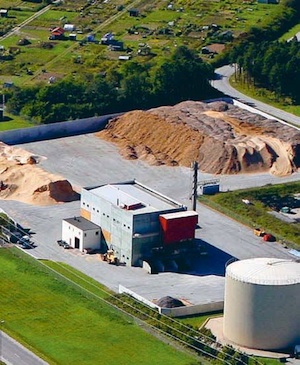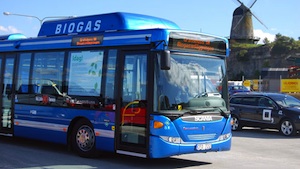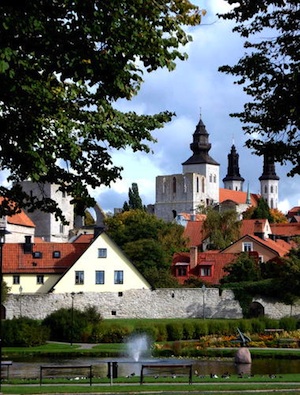Bio-fuelled district heating
A former Viking site on the island of Gotland, Visby was the main centre of the Hanseatic League in the Baltic from the 12th to the 14th century. Its 13th-century ramparts and more than 200 warehouses and wealthy merchants’ dwellings from the same period make it the best-preserved fortified commercial city in northern Europe.
Come un elemento nella conservazione degli edifici di Visby, costruzione di una rete di teleriscaldamento è iniziato qualche 30 anni fa. Ora, tutto il calore nel sistema di teleriscaldamento di Visby è prodotto utilizzando un mix di energie rinnovabili.
Visby’s district heating project is not an isolated case on an island where the use of renewable is guaranteed. Gotland is a showcase for a number of interesting and innovative renewable energy initiatives. This is not really surprising. Gotland has Sweden’s highest sunshine figures, enjoys good access to biofuels and is one of the best European locations for wind power. These natural assets, the entrepreneurship of the islanders and the municipality’s focus on strategic environmental planning have led to the realisation of many ideas for increasing the sustainability of Gotland’s local energy supply.
Biofuel nel teleriscaldamento di Visby
The World Heritage City of Visby consists of many unique buildings and mediaeval ruins that are built from limestone. Alcuni dei suoi edifici più antichi sono anche splendidamente scolpito portali e fregi in pietra arenaria Gotland. Entrambe queste pietre sono sensibili alle impurità presenti nell'aria e, in particolare, emissioni prodotte dalla combustione di combustibili fossili.
In Visby nel suo complesso, conti di teleriscaldamento per oltre 80 per cento di tutto il riscaldamento alimentato a locali commerciali e abitazioni. Per il beneficio dei residenti di Visby e patrimonio della città, questo riscaldamento contribuisce ad una società sostenibile.
Environmental benefits are evident, since fossil fuels have not been used in Visby’s district heating since 2006. Il teleriscaldamento elimina la necessità per il trasporto di carburante per le strette vie del centro storico di Visby. Inoltre, the use of biofuels reduces the emission of sulphur and nitrogen oxides. Rispetto all'uso di combustibili fossili, abbassa anche l'aggiunta netto di anidride carbonica nell'atmosfera.
Dato che 1980, emissioni di zolfo da teleriscaldamento di Visby sono diminuite di 95 cento. In confronto con riscaldamento individuale, teleriscaldamento lascia l'aria più pulita e più sana per i residenti di Visby e il patrimonio culturale sensibile della città.
La rete di teleriscaldamento a Visby prende il calore dal:
- Corteccia, ramoscelli, rami ed altre (scheggiato) residui spazi forestali e segherie.
- Una pompa di calore a base mare con un 11 MW.
- Biogas da discarica ormai chiusa a Visby.
- Biogas da l'impianto di trattamento delle acque reflue.
- Bio-oli che sostituiscono gli oli fossili.
In addition to that, the municipality has set very high standards for energy efficiency and they have launched a new plan for the historic centre, where energy aspects are integrated with a general plan for building conservation.
Eco-Municipality of Gotland
Visby is the seat of Gotland Municipality, which took the view to become “an ecologically sustainable society within the course of a generation”. Many years ago, the Municipality of Gotland adopted a route which would lead away from fossil fuels and towards reduced climate impact. Oggi, all electricity used in the municipality’s operations is certificated as Good Environmental Choice, which means that it is produced solely from renewable energy sources.
Gotland has implemented interesting reference projects in a wide range of experiences that include wind power, biogas, solar PV and sustainable architecture. The island has been a pioneer in promoting local ownership by wind co-operatives, where around 2000 households are involved.
Attualmente, one of the smartest electricity network in the world is currently under development on the island. This allows that by using modern technology, large quantities of renewable energy sources can be integrated in the grid.
Lessons learned and replicability
Visby’s bio-fuelled district heating case shows the advantages of a smart alliance between renewable energy and heritage conservation, and can be taken as a model for many historic centres at those latitudes. This project is part of the common objective of achieving energy self-sufficiency from renewables by 2025, taking into account that the realisation of a Sustainable Energy System requires action at all levels of society.
The experience of Visby, and of Gotland in general, becomes more relevant if we take into account the geographical position of the island, in the middle of the Baltic Sea, that makes it a natural meeting place for cooperation between regions in the Baltic Sea Region.


















